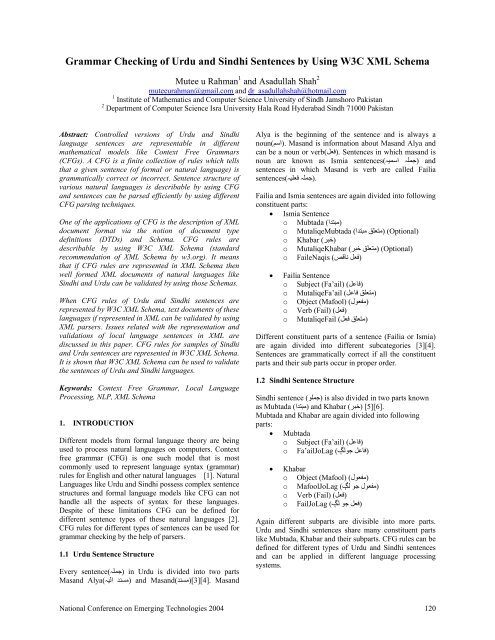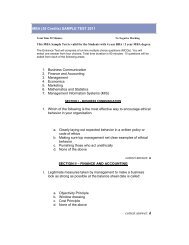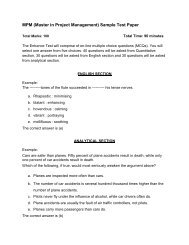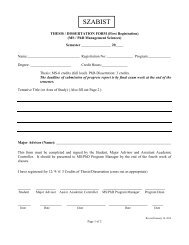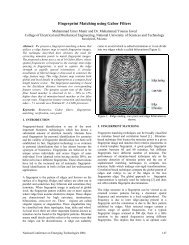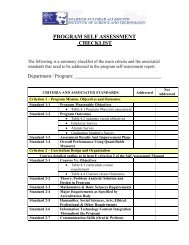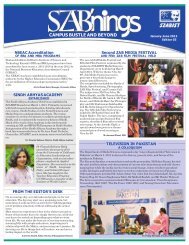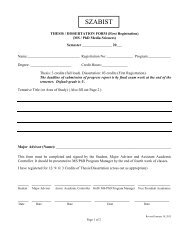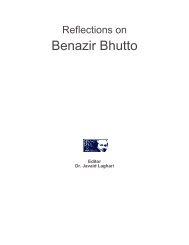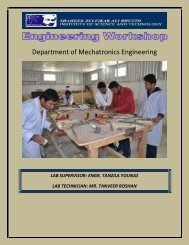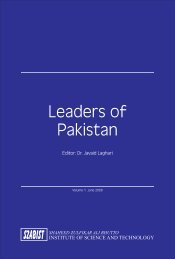Grammar Checking of Urdu and Sindhi Sentences by ... - SZABIST
Grammar Checking of Urdu and Sindhi Sentences by ... - SZABIST
Grammar Checking of Urdu and Sindhi Sentences by ... - SZABIST
You also want an ePaper? Increase the reach of your titles
YUMPU automatically turns print PDFs into web optimized ePapers that Google loves.
<strong>Grammar</strong> <strong>Checking</strong> <strong>of</strong> <strong>Urdu</strong> <strong>and</strong> <strong>Sindhi</strong> <strong>Sentences</strong> <strong>by</strong> Using W3C XML Schema<br />
Mutee u Rahman 1 <strong>and</strong> Asadullah Shah 2<br />
muteeurahman@gmail.com <strong>and</strong> dr_asadullahshah@hotmail.com<br />
1 Institute <strong>of</strong> Mathematics <strong>and</strong> Computer Science University <strong>of</strong> Sindh Jamshoro Pakistan<br />
2 Department <strong>of</strong> Computer Science Isra University Hala Road Hyderabad Sindh 71000 Pakistan<br />
Abstract: Controlled versions <strong>of</strong> <strong>Urdu</strong> <strong>and</strong> <strong>Sindhi</strong><br />
language sentences are representable in different<br />
mathematical models like Context Free <strong>Grammar</strong>s<br />
(CFGs). A CFG is a finite collection <strong>of</strong> rules which tells<br />
that a given sentence (<strong>of</strong> formal or natural language) is<br />
grammatically correct or incorrect. Sentence structure <strong>of</strong><br />
various natural languages is describable <strong>by</strong> using CFG<br />
<strong>and</strong> sentences can be parsed efficiently <strong>by</strong> using different<br />
CFG parsing techniques.<br />
One <strong>of</strong> the applications <strong>of</strong> CFG is the description <strong>of</strong> XML<br />
document format via the notion <strong>of</strong> document type<br />
definitions (DTDs) <strong>and</strong> Schema. CFG rules are<br />
describable <strong>by</strong> using W3C XML Schema (st<strong>and</strong>ard<br />
recommendation <strong>of</strong> XML Schema <strong>by</strong> w3.org). It means<br />
that if CFG rules are represented in XML Schema then<br />
well formed XML documents <strong>of</strong> natural languages like<br />
<strong>Sindhi</strong> <strong>and</strong> <strong>Urdu</strong> can be validated <strong>by</strong> using those Schemas.<br />
When CFG rules <strong>of</strong> <strong>Urdu</strong> <strong>and</strong> <strong>Sindhi</strong> sentences are<br />
represented <strong>by</strong> W3C XML Schema, text documents <strong>of</strong> these<br />
languages if represented in XML can be validated <strong>by</strong> using<br />
XML parsers. Issues related with the representation <strong>and</strong><br />
validations <strong>of</strong> local language sentences in XML are<br />
discussed in this paper. CFG rules for samples <strong>of</strong> <strong>Sindhi</strong><br />
<strong>and</strong> <strong>Urdu</strong> sentences are represented in W3C XML Schema.<br />
It is shown that W3C XML Schema can be used to validate<br />
the sentences <strong>of</strong> <strong>Urdu</strong> <strong>and</strong> <strong>Sindhi</strong> languages.<br />
Keywords: Context Free <strong>Grammar</strong>, Local Language<br />
Processing, NLP, XML Schema<br />
1. INTRODUCTION<br />
Different models from formal language theory are being<br />
used to process natural languages on computers. Context<br />
free grammar (CFG) is one such model that is most<br />
commonly used to represent language syntax (grammar)<br />
rules for English <strong>and</strong> other natural languages [1]. Natural<br />
Languages like <strong>Urdu</strong> <strong>and</strong> <strong>Sindhi</strong> possess complex sentence<br />
structures <strong>and</strong> formal language models like CFG can not<br />
h<strong>and</strong>le all the aspects <strong>of</strong> syntax for these languages.<br />
Despite <strong>of</strong> these limitations CFG can be defined for<br />
different sentence types <strong>of</strong> these natural languages [2].<br />
CFG rules for different types <strong>of</strong> sentences can be used for<br />
grammar checking <strong>by</strong> the help <strong>of</strong> parsers.<br />
1.1 <strong>Urdu</strong> Sentence Structure<br />
Every (جملہ)sentence in <strong>Urdu</strong> is divided into two parts<br />
Mas<strong>and</strong> اليہ)Alya (مسند <strong>and</strong> .[3][4](مسند)Mas<strong>and</strong> Mas<strong>and</strong><br />
Alya is the beginning <strong>of</strong> the sentence <strong>and</strong> is always a<br />
.(اسم)noun Mas<strong>and</strong> is information about Mas<strong>and</strong> Alya <strong>and</strong><br />
can be a noun or .(فعل)verb <strong>Sentences</strong> in which mas<strong>and</strong> is<br />
noun are known as Ismia اسميہ)sentences (جملہ <strong>and</strong><br />
sentences in which Mas<strong>and</strong> is verb are called Failia<br />
.(جملہ فعليہ)sentences<br />
Failia <strong>and</strong> Ismia sentences are again divided into following<br />
constituent parts:<br />
• Ismia Sentence<br />
(مبتدا) o Mubtada<br />
o MutaliqeMubtada مبتدا) (متعلق (Optional)<br />
(خبر) o Khabar<br />
o MutaliqeKhabar خبر) (متعلق (Optional)<br />
o<br />
(فعل ناقص) FaileNaqis<br />
• Failia Sentence<br />
(فاعل) (Fa’ail) o Subject<br />
o<br />
(مفعول) (Mafool) o Object<br />
(فعل) (Fail) o Verb<br />
o<br />
(متعلق فاعل) MutaliqeFa’ail<br />
(متعلق فعل) MutaliqeFail<br />
Different constituent parts <strong>of</strong> a sentence (Failia or Ismia)<br />
are again divided into different subcategories [3][4].<br />
<strong>Sentences</strong> are grammatically correct if all the constituent<br />
parts <strong>and</strong> their sub parts occur in proper order.<br />
1.2 <strong>Sindhi</strong> Sentence Structure<br />
<strong>Sindhi</strong> sentence (جملو) is also divided in two parts known<br />
[5][6]. (خبر) <strong>and</strong> Khabar (مبتدا) as Mubtada<br />
Mubtada <strong>and</strong> Khabar are again divided into following<br />
parts:<br />
• Mubtada<br />
(فاعل) (Fa’ail) o Subject<br />
(فاعل جو لڳ ( Fa’ailJoLag o<br />
• Khabar<br />
(مفعول) (Mafool) o Object<br />
(مفعول جو لڳ ( MafoolJoLag o<br />
(فعل) (Fail) o Verb<br />
(فعل جو لڳ ( FailJoLag o<br />
Again different subparts are divisible into more parts.<br />
<strong>Urdu</strong> <strong>and</strong> <strong>Sindhi</strong> sentences share many constituent parts<br />
like Mubtada, Khabar <strong>and</strong> their subparts. CFG rules can be<br />
defined for different types <strong>of</strong> <strong>Urdu</strong> <strong>and</strong> <strong>Sindhi</strong> sentences<br />
<strong>and</strong> can be applied in different language processing<br />
systems.<br />
National Conference on Emerging Technologies 2004 120
1.3 XML <strong>and</strong> XML Schema<br />
XML (eXtensible Markup Language) is a st<strong>and</strong>ard for the<br />
representation, communication <strong>and</strong> validation <strong>of</strong> data [7].<br />
XML is being frequently used for creating user defined<br />
markup languages, document validation, architecture<br />
independent data representation <strong>and</strong> validation, web<br />
service communication <strong>and</strong> other Internet applications<br />
[8][9]. Different applications like Micros<strong>of</strong>t Office,<br />
programming languages like Java <strong>and</strong> DBMS like Oracle<br />
now have intrinsic support for XML data processing <strong>and</strong><br />
representations.<br />
XML DTD (Document Type Definition) <strong>and</strong> XML<br />
Schema are formalisms for the representation <strong>of</strong> XML<br />
document validation rules. DTDs define an XML<br />
document’s structure. But because <strong>of</strong> some limitations<br />
DTDs are not being used widely for the validations <strong>of</strong><br />
XML documents [9]. XML Schemas are an alternative to<br />
DTDs. Unlike DTDs schemas make use <strong>of</strong> XML for rule<br />
definitions <strong>and</strong> therefore are XML documents. This makes<br />
them more flexible, powerful <strong>and</strong> suitable for defining<br />
XML document structures.<br />
W3C Schema is st<strong>and</strong>ard recommendation for XML<br />
documents <strong>by</strong> w3.org. W3C schema is capable enough to<br />
represent CFG rules. Once <strong>Urdu</strong> <strong>and</strong> <strong>Sindhi</strong> sentence CFG<br />
rules are represented in W3C XML Schema, different<br />
applications can use those schema definitions for <strong>Urdu</strong> <strong>and</strong><br />
<strong>Sindhi</strong> sentence processing. In subsequent sections<br />
schemas for <strong>Urdu</strong> <strong>and</strong> <strong>Sindhi</strong> sentences are defined <strong>and</strong><br />
shown that how different applications can use those<br />
schemas to check the grammar <strong>of</strong> sentences.<br />
2. W3C XML SCHEMA FOR CFG RULES OF<br />
URDU SENTENCE<br />
CFG rules for Ismia <strong>and</strong> Failia <strong>Sentences</strong> <strong>of</strong> <strong>Urdu</strong> are<br />
given below:<br />
←<br />
←<br />
جملہ اسميہ<br />
جملہ جملہ فعليہ<br />
جملہ جملہ اسميہ ← مسند اليہ مسند فعل ناقص<br />
جملہ فعليہ ← مسند اليہ مسند<br />
مبتدا متعلق مبتدا<br />
مسند اليہ متعلق مبتدا (Optional) مبتدا<br />
مسند اليہ (Optional)<br />
فاعل متعلق فاعل مسند اليہ متعلق فاعل (Optional) فاعل<br />
مسند اليہ متعلق فعل (Optional) مفعول(Optional)<br />
مسند متعلق مفعول (Optional) فعل<br />
متعلق فعل (Optional) فعل<br />
مسند خبر متعلق خبر<br />
مسند متعلق خبر (Optional) خبر<br />
مسند فاعل<br />
اسم<br />
متعلق مبتدا ← ميرا<br />
اسم<br />
متعلق فاعل← ميرا<br />
اسم<br />
مفعول<br />
متعلق خبر ← سارے<br />
(Optional)<br />
(Optional)<br />
←<br />
←<br />
←<br />
←<br />
←<br />
←<br />
←<br />
←<br />
مبتدا ←<br />
مبتدا ←<br />
فاعل ←<br />
خبر ←<br />
خبر ←<br />
| اکبر | بندرگاہ | دوست<br />
فعل ناقص ہے<br />
اسم<br />
فعل گيا ہے<br />
متعلق فعل ← آج<br />
اسم کراچی<br />
←<br />
مفعول ←<br />
←<br />
Different Ismia <strong>and</strong> Failia sentences can be derived <strong>by</strong><br />
using above CFG [2]. A sentence is grammatically correct<br />
if it is derivable <strong>by</strong> using above grammar. For example<br />
) are<br />
grammatically correct according to above CFG.<br />
اکبرآج کراچی گي اہے ( <strong>and</strong> (اکبر ميرا دوست ہے (<br />
W3C XML Schema for Ismia <strong>and</strong> Failia Sentence CFG<br />
rules given above is as follows:<br />
<br />
<br />
<br />
<br />
<br />
<br />
--> (جملہ اسميہ) (جملہ فعليہ) <br />
<br />
<br />
<br />
<br />
<br />
<br />
<br />
<br />
<br />
<br />
<br />
<br />
<br />
اليہ<br />
←<br />
National Conference on Emerging Technologies 2004 121
<br />
<br />
<br />
<br />
<br />
<br />
<br />
<br />
<br />
--> (مسند) <br />
<br />
<br />
<br />
<br />
<br />
<br />
<br />
<br />
<br />
<br />
<br />
<br />
<br />
<br />
<br />
<br />
<br />
<br />
<br />
مفعول)MutaliqeMafool--!> (متعلق Definition
<br />
<br />
<br />
<br />
<br />
<br />
<br />
"="/> ے <br />
<br />
<br />
<br />
<br />
<br />
<br />
<br />
(اسم)Isam—!> Definition --><br />
<br />
<br />
<br />
<br />
<br />
<br />
<br />
<br />
<br />
<br />
<br />
هن<br />
National Conference on Emerging Technologies 2004 123
<br />
<br />
<br />
<br />
<br />
<br />
<br />
<br />
<br />
<br />
<br />
<br />
<br />
<br />
<br />
<br />
4. RESULTS<br />
Altova Style Vision 2005 <strong>and</strong> Micros<strong>of</strong>t Excel 2003<br />
Pr<strong>of</strong>essional Edition are used here to demonstrate the use<br />
<strong>of</strong> W3C XML Schema for <strong>Sindhi</strong> sentence validation (see<br />
Figure 1). Figure 2 shows the demonstration <strong>of</strong> invalid<br />
XML sentences in AltovaStyle Vision 2005.<br />
Figure 1. Validation <strong>of</strong> <strong>Sindhi</strong> XML <strong>Sentences</strong> in<br />
Altova StyleVision 2005 <strong>by</strong> using <strong>Sindhi</strong><br />
sentence XML schema.<br />
Figure 2. Error message for invalid <strong>Sindhi</strong> XML<br />
<strong>Sentences</strong> in AltovaStyleVision 2005.<br />
Micros<strong>of</strong>t Excel 2003 Pr<strong>of</strong>essional Edition also supports<br />
schema validated data <strong>by</strong> applying XML maps. New XML<br />
map can be created <strong>by</strong> using following steps:<br />
1. On the Data menu, point to XML, <strong>and</strong> then click<br />
XML Source to open the XML Source task pane.<br />
2. To map one or more elements to your worksheet,<br />
select the elements in the XML Source task pane. To<br />
select nonadjacent elements, click one element, <strong>and</strong><br />
then hold down CTRL <strong>and</strong> click each element.<br />
3. Drag the selected elements to the worksheet location<br />
where you want them to appear.<br />
National Conference on Emerging Technologies 2004 124
Once XML map is created one can import valid <strong>Sindhi</strong><br />
XML files into Excel sheet. XML map for <strong>Sindhi</strong><br />
Sentence <strong>by</strong> using W3C XML Schema with valid XML<br />
document data import is shown in Figure 3.<br />
Micros<strong>of</strong>t Word 2003 Pr<strong>of</strong>essional Edition, Micros<strong>of</strong>t<br />
Excel 2003 Pr<strong>of</strong>essional Edition <strong>and</strong> Altova Style Vision.<br />
W3C XML Schema for <strong>Sindhi</strong> <strong>and</strong> <strong>Urdu</strong> can also be used<br />
for automated sentence generation systems, natural<br />
language interfaces to computers, machine translation <strong>and</strong><br />
for knowledge representation <strong>of</strong> AI systems.<br />
REFERENCES<br />
[1] Daniel Jurafsky & James H. Martin. Speech <strong>and</strong><br />
Language Processing An Introduction to Natural<br />
Language Processing, Computational Linguistics <strong>and</strong><br />
Speech Recognition. Pearson Education Series 2002.<br />
Figure 3. Valid XML data import <strong>by</strong> using W3C XML<br />
Schema map in Micros<strong>of</strong>t Excel 2003.<br />
5. CONCLUSION<br />
CFGs can h<strong>and</strong>le many aspects <strong>of</strong> natural language syntax.<br />
Languages like <strong>Urdu</strong> <strong>and</strong> <strong>Sindhi</strong> have complex sentence<br />
structure which is not completely describable <strong>by</strong> CFG.<br />
Even though CFGs are considerably useful for the<br />
description <strong>of</strong> syntax rules <strong>of</strong> <strong>Urdu</strong> <strong>and</strong> <strong>Sindhi</strong> sentences.<br />
CFGs are also used for the description <strong>of</strong> data validation<br />
rules in XML documents. W3C XML schema is st<strong>and</strong>ard<br />
formalism for the description <strong>of</strong> data validation rules.<br />
CFGs are completely describable <strong>by</strong> XML Schemas, it<br />
means CFGs <strong>of</strong> <strong>Urdu</strong> <strong>and</strong> <strong>Sindhi</strong> sentences can be<br />
converted into XML Schemas <strong>and</strong> those Schemas can be<br />
used for the validation <strong>of</strong> <strong>Urdu</strong> <strong>and</strong> <strong>Sindhi</strong> XML<br />
documents.<br />
Because schemas are XML documents therefore they are<br />
flexible, reprogrammable <strong>and</strong> easily deployable in any<br />
type <strong>of</strong> application. Schemas can be embedded in different<br />
applications without any special consideration. If valid<br />
XML Schemas are created for different types <strong>of</strong> <strong>Urdu</strong> <strong>and</strong><br />
<strong>Sindhi</strong> sentences then it is possible to check the grammar<br />
<strong>of</strong> those sentences in any type <strong>of</strong> application with XML<br />
support. XML Schemas given in above sections can be<br />
used very easily <strong>and</strong> effectively in applications like<br />
[2] Mutee-u-Rahman, Asadullah Shah. <strong>Grammar</strong><br />
<strong>Checking</strong> Model for Local Languages. In proceedings<br />
to the SCONEST (Student Conference on Engineering<br />
Sciences <strong>and</strong> Technology) 2003. SCON-S15,<br />
Hamdard & Bahria University Karachi Pakistan,<br />
October 2003.<br />
[3] Bashir Ahmed Siddiqui. Jadid <strong>Urdu</strong> Composition.<br />
Kitabistan Publishing Company 2000.<br />
[4] Ghulam Jilani Makhdoom. Darsi <strong>Urdu</strong> Composition.<br />
Darsi Idara Limited Educational Publishers 1992.<br />
[5] Hassan Ali Thaeem. <strong>Sindhi</strong> <strong>Grammar</strong> <strong>and</strong><br />
Composition. Rehbar Publishers 2001.<br />
[6] Ali Muhammad Baloch. Rahber-e-<strong>Sindhi</strong><br />
Composition <strong>and</strong> <strong>Grammar</strong>. Gaba Educational Books<br />
2000.<br />
[7] Elliotte Rusty Harold. XML Bible. Hungry Minds Inc<br />
2001.<br />
[8] K. M. Goeschka, Helmut Reis, Robert Smeikal. XML<br />
Based Robust Client-Server Communication for a<br />
Distributed Telecommunication Management System.<br />
36th Annual Hawaii International Conference on System<br />
Sciences (HICSS'03). pp. 122c - Track 4. January 2003<br />
IEEE.<br />
[9] Petr Kroha, Lars Gemeinhardt. Using XML in a Web-<br />
Oriented Information System. 12th International<br />
Workshop on Database <strong>and</strong> Expert Systems<br />
Applications. September 2001 IEEE.<br />
National Conference on Emerging Technologies 2004 125


